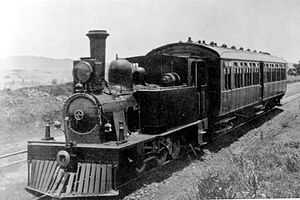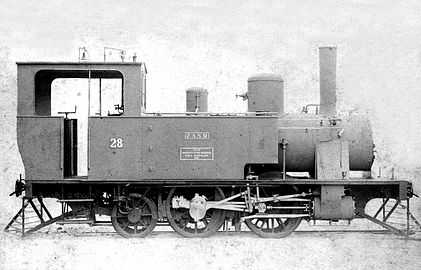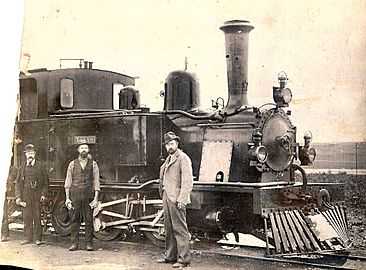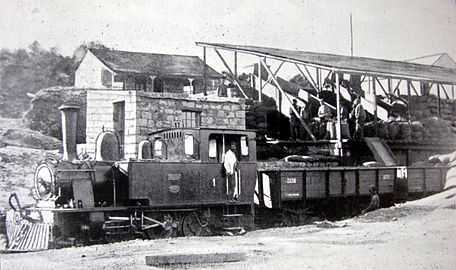NZASM 19 Tonner 0-4-2T
| NZASM 19 Tonner 0-4-2T to CSAR Railmotor Engine 0-4-2T | |
|---|---|
|
19 Tonner no. 34 at Johannesburg Station on the first train to reach Johannesburg from Cape Town, 15 September 1892 | |
| Type and origin | |
| Power type | Steam |
| Designer | Maschinenfabrik Esslingen |
| Builder |
Maschinenfabrik Esslingen Machinefabriek Breda v/h Backer & Rueb |
| Serial number | Esslingen 2366-2370, 2408-2412 & 2506-2513, Breda 83-88 |
| Build date | 1890-1892 |
| Total produced | 24 |
| Rebuilder | Central South African Railways |
| Rebuild date | 1906, 1908-1909 |
| Number rebuilt | 10 |
| Specifications | |
| Configuration | 0-4-2T |
| Gauge | 3 ft 6 in (1,067 mm) Cape gauge |
| Driver diameter | 43 7⁄16 in (1,100 mm) |
| Trailing wheel diameter | 30 in (762 mm) |
| Wheelbase | 8 ft 2 1⁄2 in (2.502 m) |
| Length | 25 ft 1 1⁄8 in (7.649 m) over buffers |
| Height | 11 ft 8 1⁄16 in (3.558 m) |
| Axle load |
6 long tons 5 cwt (6.4 t) per driver 6 long tons 10 cwt (6.6 t) trailing |
| Weight on drivers | 12 long tons 10 cwt (12.7 t) |
| Locomotive weight | 19 long tons (19 t) w/o |
| Fuel type | Coal |
| Fuel capacity | 1 long ton 10 cwt (1.5 t) |
| Water capacity | 550 imp gal (2,500 l; 660 US gal) |
| Boiler |
3 ft 2 1⁄2 in (0.978 m) outside diameter 8 ft 0 1⁄8 in (2.442 m) inside length 5 ft 6 3⁄4 in (1.695 m) pitch |
| Boiler pressure | 160 psi (1,100 kPa) |
| Firegrate area | 7.2 sq ft (0.669 m2) |
| Heating surface: – Tubes |
95 tubes of 1 3⁄4 in (44.4 mm) diameter 388.4 sq ft (36.084 m2) |
| – Firebox | 38.2 sq ft (3.549 m2) |
| – Total | 426.6 sq ft (39.632 m2) |
| Cylinders | Two |
| Cylinder size |
11 in (279 mm) bore 21 21⁄32 in (550 mm) stroke |
| Valve gear | Allan link |
| Performance figures | |
| Tractive effort | 7,744 lbf (34 kN) at 75% pressure |
| Career | |
| Operator(s) |
NZASM Imperial Military Railways Central South African Railways South African Railways |
| Class | NZASM 19 Tonner |
| Number in class | 24 |
| Number(s) |
NZASM 15-38 IMR 612-635 CSAR F-V, then M1 & M3-M11 |
| Official name | 19 Tonner |
| Delivered | 1891 |
| First run | 1891[1] |
The NZASM 19 Tonner 0-4-2T of 1891 is a South African steam locomotive from the pre-Union era in the Transvaal.
In 1891 and 1892 the Nederlandsche-Zuid-Afrikaansche Spoorweg-Maatschappij of the Zuid-Afrikaansche Republiek (Transvaal Republic) placed twenty-four tank locomotives with a 0-4-2 wheel arrangement in service. Since the railway classified its locomotives according to their weight, these locomotives were known as the 19 Tonners.[1]
Manufacturers
The first ten of eventually twenty-four tank locomotives with a 0-4-2 wheel arrangement, built in two batches of five by Emil Kessler’s Maschinenfabrik Esslingen in 1890, were placed in service by the Nederlandsche-Zuid-Afrikaansche Spoorweg-Maatschappij (NZASM) in 1891 and numbered in the range from 21 to 30. Since the NZASM classified its locomotives according to their weight, these locomotives were known as 19 Tonners.[1]
The 19 Tonners were equipped with Allan link valve gear, mounted externally and driven by eccentric sheaves that were mounted on a return crank.[1]
Since they proved to be useful locomotives, an order for six more of the type was placed with Machinefabriek Breda voorheen Backer & Rueb (Breda machine factory, formerly Backer & Rueb). They were built in 1891 and 1892 and were numbered in the range from 15 to 20, but for some reason, possibly their delivery sequence, their numbering was not in the same sequence as their works numbers.[1]
Eight more 19 Tonners were delivered from Maschinenfabrik Esslingen in 1892, numbered in the range from 31 to 38.[1]
Service
NZASM
At the time the 19 Tonners entered service, the Randtram line and the extensions towards the east to Springs and towards the west to Roodepoort were open. The extension from Roodepoort to Krugersdorp was opened on 10 February 1891, while the extension from Germiston to Pretoria was still in progress and only to be completed in December 1892. These are the lines on which the 19 Tonners entered service.[2]
Imperial Military Railways
All railway operations in the two Boer Republics, the Zuid-Afrikaansche Republiek and the Orange Free State, were taken over by the Imperial Military Railways (IMR) in 1899, during the South African War.[2] The IMR renumbered the 19 Tonners in the range from 612 to 635.[3]
Central South African Railways
At the end of the war, when the IMR was transformed into the Central South African Railways (CSAR), twenty-two of the 19 Tonners had survived the hostilities. Five, IMR numbers 613 and 631 and three more, had been sold by the IMR and the other seventeen were renumbered by the CSAR in the letter range from F to V, following on from the 18 Tonner renumbering.[3]
Three were retired from CSAR service and converted to stationary boilers, numbered in the range from 1735 to 1737. Between 1906 and 1909 ten of them were converted to railmotor engines for use on suburban services. This entailed being semi-permanently coupled to a modified fifty-two seat passenger coach that contained a driving cab at the rear, with the controls arranged so that the push-pull unit could be driven from either vehicle. These railmotor engines were renumbered in the range M1 and M3 to M11.[3][4][5]

The skipped number M2 was allocated to a Kitson-built railmotor with a fifty-six passenger capacity that was placed in service in 1907. In service, the imported railmotor no. M2 was found to be less satisfactory than the home-built railmotor engine no. M1, which was considered to be superior in aspects like design, passenger comfort, economy in running and convenience in working. Since the imported railmotor was a single vehicle, the carriage was unusable while the engine had to be withdrawn for service or repairs. The Pretoria-built modified coach was still readily detachable from the locomotive and both engine and coach were still complete units which could be used independently of each other.[5]
Since several 19 Tonners were standing idle, no more railmotors were ordered and another nine 19 Tonners were converted to railmotor engines and renumbered in the range M3 to M11. Between 1906 and 1909 steam railmotor services were expanded to operate on four routes.[3][5]
- Hatherley-Pretoria-Wonderboom.
- Elsburg-Germiston-Rietfontein Mine.
- Luipaardsvlei-Krugersdorp-Randfontein.
- Germiston-Geduld.
South African Railways
The Union of South Africa was established on 31 May 1910, in terms of the South Africa Act. One of the clauses in the Act required that the three Colonial Government railways, the Cape Government Railways, the Natal Government Railways and the CSAR, also be united under one single administration to control and administer the railways, ports and harbours of the Union. While the South African Railways (SAR) came into existence in 1910, the actual classification and renumbering of all the rolling stock of the three constituent railways required careful planning and was only implemented with effect from 1 January 1912.[2][6]
In 1912 the ten railmotor engines were taken onto the SAR roster as unclassified locomotives since they were considered obsolete. Since they were excluded from the SAR renumbering schedules,[6] they retained their CSAR engine numbers, but at some stage their boilers were allocated SAR boiler numbers in the range 4000 and 4002 to 4010. The skipped no. 4001 was used for the Kitson railmotor’s boiler.[3] All of them were withdrawn from service by 1921.[4]
Industry
At least five 19 Tonners were sold to industry before the formation of the CSAR. Known locomotives in industrial service were one at Coronation Colliery, one at Douglas Colliery and one at Transvaal Coal Trust in Brakpan which later went to Ogies Colliery. The one at Ogies was only scrapped circa 1930 and may have been the last survivor.[3]
The Douglas Colliery locomotive was their no. 1 and was named "Douglas". It bore a Breda works plate and was therefore one of the batch from the NZASM number range from 15 to 20. Since, out of the Breda group, NZASM no. 16 is the only one that definitely did not pass to the CSAR and there is uncertainty over whether or not NZASM no. 20 became one of CSAR numbers J, K or L, it follows that either no. 16 or no. 20 became Douglas Colliery no. 1.[3]
Works numbers and renumbering
The 19 Tonner NZASM numbers, builders, works numbers, year built, IMR renumbering, CSAR renumbering, CSAR railmotor engine conversion date or stationary boiler renumbering, and SAR boiler numbering are shown in the table.[1][3]
NZASM no. |
Builder | Works no. |
Year built |
IMR no. |
CSAR no. |
CSAR RME or st. boiler no. |
SAR boiler no. |
|---|---|---|---|---|---|---|---|
| 15 | Breda | 85 | 1891-92 | 612 | F | M 4 (1908–11) | 4003 |
| 16 | Breda | 86 | 1891-92 | 613 | |||
| 17 | Breda | 87 | 1891-92 | 614 | G | M 1 (1906-04) | 4000 |
| 18 | Breda | 88 | 1891-92 | 615 | H | ||
| 19 | Breda | 83 | 1891-92 | 616 | I | M 8 (1909-07) | 4007 |
| 20 | Breda | 84 | 1891-92 | 617 | J, K, L? | ||
| 21 | Esslingen | 2366 | 1890 | 618 | J, K, L? | St. Blr. 1735 | |
| 22 | Esslingen | 2367 | 1890 | 619 | J, K, L? | ||
| 23 | Esslingen | 2368 | 1890 | 620 | J, K, L? | ||
| 24 | Esslingen | 2369 | 1890 | 621 | M | M11 (1909) | 4010 |
| 25 | Esslingen | 2370 | 1890 | 622 | N | M 5 (1909-07) | 4004 |
| 26 | Esslingen | 2408 | 1890 | 623 | O | M 6 (1909-06) | 4005 |
| 27 | Esslingen | 2409 | 1890 | 624 | P | M 7 (1909-06) | 4006 |
| 28 | Esslingen | 2410 | 1890 | 625 | Q | M10 (1909) | 4009 |
| 29 | Esslingen | 2411 | 1890 | 626 | R, S? | St. Blr. 1736 | |
| 30 | Esslingen | 2412 | 1890 | 627 | R, S? | ||
| 31 | Esslingen | 2506 | 1892 | 628 | R, S? | ||
| 32 | Esslingen | 2507 | 1892 | 629 | R, S? | ||
| 33 | Esslingen | 2508 | 1892 | 630 | T | M 3 (1908–10) | 4002 |
| 34 | Esslingen | 2509 | 1892 | 631 | |||
| 35 | Esslingen | 2510 | 1892 | 632 | U | M 9 (1909) | 4008 |
| 36 | Esslingen | 2511 | 1892 | 633 | V? | ||
| 37 | Esslingen | 2512 | 1892 | 634 | V? | St. Blr. 1737 | |
| 38 | Esslingen | 2513 | 1892 | 635 | V? | ||
Sides illustrated
The pictures below serve to illustrate both sides of the 19 Tonner locomotive.
-

Esslingen-built no. 28, circa 1891
-

Breda-built no. 17, circa 1895
-

Esslingen-built no. 31, circa 1895
-

Breda-built Douglas Colliery no. 1, circa 1900
See also
- CSAR Railmotor
- List of South African locomotive classes
- South African locomotive history
- The 0-4-2 wheel arrangement
References
|
- ↑ 1.0 1.1 1.2 1.3 1.4 1.5 1.6 Holland, D.F. (1971). Steam Locomotives of the South African Railways, Volume 1: 1859-1910 (1st ed.). Newton Abbott, Devon: David & Charles. pp. 110–111. ISBN 978-0-7153-5382-0.
- ↑ 2.0 2.1 2.2 The South African Railways - Historical Survey. Editor George Hart, Publisher Bill Hart, Sponsored by Dorbyl Ltd., Published c. 1978, pp. 19-20, 22-23, 25.
- ↑ 3.0 3.1 3.2 3.3 3.4 3.5 3.6 3.7 19 Tonner Information supplied by John Nicholas Middleton
- ↑ 4.0 4.1 Paxton, Leith; Bourne, David (1985). Locomotives of the South African Railways (1st ed.). Cape Town: Struik. p. 24. ISBN 0869772112.
- ↑ 5.0 5.1 5.2 CSAR General Manager's Report, Extracts from the CSAR General Manager's Reports for 1906, 1907, 1908 & 1909.
- ↑ 6.0 6.1 Classification of S.A.R. Engines with Renumbering Lists, issued by the Chief Mechanical Engineer’s Office, Pretoria, January 1912, p. 2 (Reprinted in April 1987 by SATS Museum, R.3125-6/9/11-1000)